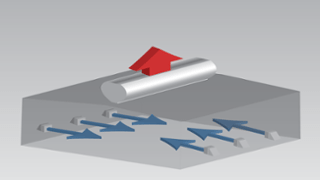How Does a Pressure Gravity System Work?
How Does a Pressure Gravity System Work? A Pressure Gravity System, also known as hybrid ventilation system, is one of the oldest ways to obtain fresh airflow in an enclosed space. Each Pressure Gravity System uses positive pressure to help ventilate manufacturing and industrial properties. Temperature differentials between the air inlets at the floor level and the ventilator at the roof level contribute to the movement of air. By exploiting the natural convection effect, air can be exhaust through the roof of a building naturally.
Powered exhaust fans assist this process by forcing cool, clean air into the building at a high velocity. Powered fan systems promote air flow and reduce temperature differentials inside and outside of a building. Not only is this form of cooling environmentally friendly, but it also saves significant amounts in energy costs.
How Does A Pressure Gravity System® Work
The pressure gravity concept is often used in spaces such as large manufacturing and industrial spaces. To create a Pressure Gravity System® the first step is to create a roof opening. This opening is covered by a natural ventilator such as a MoffittVent and is designed to let air naturally exhaust from the building.
Next, a team will install intake wall fans near ground level to provide supply air. The fans focus on troubled “hot spots”. The discharge end faces into the building, giving the workers a nice breeze. The air travels deep into the building, cooling workers off even when they aren’t right by the exhaust. Strategically placed fans pressurize the building.
This combination of the passive exhaust with active intake results in superior air movement. Furthermore, this leads to an increased cooling effect inside of the building.
Additionally, a byproduct of this system means that the supply fans are moving cool, clean air, as opposed to hot, dirty air. This removes the fans’ exposure to the hot, humid conditions that over-tax exhaust fans and lead to rusting. As a result, there is less maintenance and fewer repairs. Of course, this also means the fan maintenance is easier. Due to the fact that they are at ground level instead of the roof they are easier to access.
Difference Between a Pressure Gravity System and a Natural Ventilation System?
Fortunately, designing for a Pressure Gravity System® is relatively easy. First, a ventilation engineer will analyze a building’s temperatures and dimensions. Then, they will determine the best location for exhaust points. Next, the designer will find the ideal intake fan by looking at the building CFM. Finally, the designer will find the right fans to ensure the best system possible for that space.
A Pressure Gravity System® requires less square footage for gravity ventilators than a natural system. In addition, powered supply fans in a hybrid system creates a higher-pressure differential than that created by natural ventilation. This increases the air velocity through the ventilator.
Gravity ventilation is an energy efficient way to naturally cool buildings. It uses less energy on average than a powered exhaust system and it can be designed to fit your specific building’s needs. The system can grow and change with your building over time. Meeting cooling requirements as your business or facility changes.
Moffitt offers an array of ventilation products including those for natural ventilation, axial fans, specialty fans, centrifugal plans, and heaters. Moffitt is the only place you can get a Pressure Gravity System®. We pride ourselves on being the leading ventilation designer since 1961. We have satisfied customers all over the U.S. and the world.

